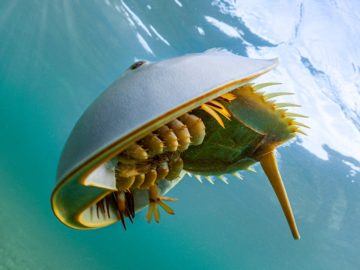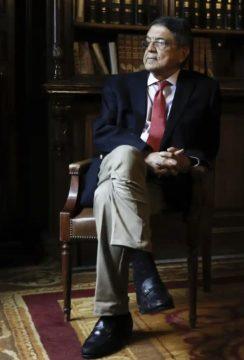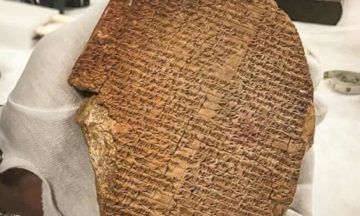Henry Nicholls in Nature:
 Rich in meaning and metaphor, the word ‘heart’ conjures up many images: a pump, courage, kindness, love, a suit in a deck of cards, a shape or the most important part of an object or matter. These days, it also brings to mind the global increase in heart attacks and cardiovascular damage that attends COVID-19. As a subject for a book, the heart is an organ with a lot going for it.
Rich in meaning and metaphor, the word ‘heart’ conjures up many images: a pump, courage, kindness, love, a suit in a deck of cards, a shape or the most important part of an object or matter. These days, it also brings to mind the global increase in heart attacks and cardiovascular damage that attends COVID-19. As a subject for a book, the heart is an organ with a lot going for it.
Enter zoologist Bill Schutt. His book Pump refuses to tie the heart off from the circulatory system, and instead uses it to explore how multicellular organisms have found various ways to solve the same fundamental challenge: satisfying the metabolic needs of cells that are beyond the reach of simple diffusion. He writes of the co-evolution of the circulatory and respiratory systems: “They cooperate, they depend on each other, and they are basically useless by themselves.” At his best, Schutt guides us on a journey from the origin of the first contractile cells more than 500 million years ago to the emergence of vertebrates, not long afterwards. He takes in, for example, horseshoe crabs, their blood coloured blue by the presence of the copper-based oxygen-transport protein haemocyanin (equivalent to humans’ iron-based haemoglobin).
We learn that insects, lacking a true heart, have a muscular dorsal vessel that bathes their tissues in blood-like haemolymph. Earthworms, too, are heartless but with a more complex arrangement of five pairs of contractile vessels. Squid and other cephalopods have three distinct hearts. The are plenty of zoological nuggets to enjoy along the way. The tubular heart of a sea squirt, for instance, contains pacemaker-like cells that enable it to pump in one direction and then the other. Some creatures need masses of oxygen, others little, leading to more diversity. The plethodontids (a group of salamanders) have neither lungs nor gills, he explains: their relatively small oxygen requirements are met by diffusion through the skin.
More here.
 Back in 2000, when Michael Elowitz of the California Institute of Technology was still a grad student at Princeton University, he accomplished a remarkable feat in the young field of synthetic biology: He became one of the first to design and demonstrate a kind of functioning “circuit” in living cells. He and his mentor, Stanislas Leibler, inserted a suite of genes into Escherichia coli bacteria that induced controlled swings in the cells’ production of a fluorescent protein, like an oscillator in electronic circuitry.
Back in 2000, when Michael Elowitz of the California Institute of Technology was still a grad student at Princeton University, he accomplished a remarkable feat in the young field of synthetic biology: He became one of the first to design and demonstrate a kind of functioning “circuit” in living cells. He and his mentor, Stanislas Leibler, inserted a suite of genes into Escherichia coli bacteria that induced controlled swings in the cells’ production of a fluorescent protein, like an oscillator in electronic circuitry.
 I travelled to New York City in August for the first time since the pandemic began, to visit friends who had just bought their first home. They are firmly upper-middle class and in their 40s. They took out a mortgage for $1.5m (£1.1m) to buy a place in a Brooklyn neighbourhood that was regarded until recently as an area immune to gentrification. So far, so typical. Asset ownership comes late these days.
I travelled to New York City in August for the first time since the pandemic began, to visit friends who had just bought their first home. They are firmly upper-middle class and in their 40s. They took out a mortgage for $1.5m (£1.1m) to buy a place in a Brooklyn neighbourhood that was regarded until recently as an area immune to gentrification. So far, so typical. Asset ownership comes late these days. Rich in meaning and metaphor, the word ‘heart’ conjures up many images: a pump, courage, kindness, love, a suit in a deck of cards, a shape or the most important part of an object or matter. These days, it also brings to mind the global increase in heart attacks and cardiovascular damage that attends COVID-19. As a subject for a book, the heart is an organ with a lot going for it.
Rich in meaning and metaphor, the word ‘heart’ conjures up many images: a pump, courage, kindness, love, a suit in a deck of cards, a shape or the most important part of an object or matter. These days, it also brings to mind the global increase in heart attacks and cardiovascular damage that attends COVID-19. As a subject for a book, the heart is an organ with a lot going for it. What is found in a good conversation? It is certainly correct to say words—the more engagingly put, the better. But conversation also includes “eyes, smiles, the silences between the words,” as the Swedish author Annika Thor wrote. It is when those elements hum along together that we feel most deeply engaged with, and most connected to, our conversational partner, as if we are in sync with them. Like good conversationalists, neuroscientists at Dartmouth College have taken that idea and carried it to new places. As part of a series of studies on how two minds meet in real life, they reported surprising findings on the interplay of eye contact and the synchronization of neural activity between two people during conversation. In a paper published on September 14 in Proceedings of the Natural Academy of Sciences USA, the researchers suggest that being in tune with a conversational partner is good but that
What is found in a good conversation? It is certainly correct to say words—the more engagingly put, the better. But conversation also includes “eyes, smiles, the silences between the words,” as the Swedish author Annika Thor wrote. It is when those elements hum along together that we feel most deeply engaged with, and most connected to, our conversational partner, as if we are in sync with them. Like good conversationalists, neuroscientists at Dartmouth College have taken that idea and carried it to new places. As part of a series of studies on how two minds meet in real life, they reported surprising findings on the interplay of eye contact and the synchronization of neural activity between two people during conversation. In a paper published on September 14 in Proceedings of the Natural Academy of Sciences USA, the researchers suggest that being in tune with a conversational partner is good but that  On a December morning in 1947 when three fellows at Princeton’s Institute for Advanced Study set out for the Third Circuit Court in Trenton, it was decided that the job of making sure that the brilliant but naively innocent logician Kurt Gödel didn’t say something intemperate at his citizenship hearing would fall to Albert Einstein. Economist Oscar Morgenstern would drive, Einstein rode shotgun, and a nervous Gödel sat in the back. With squibs of low winter light, both wave and particle, dappled across the rattling windows of Morgenstern’s car, Einstein turned back and asked, “Now, Gödel, are you really well prepared for this examination?” There had been no doubt that the philosopher had adequately studied, but as to whether it was proper to be fully honest was another issue. Less than two centuries before, and the signatories of the U.S. Constitution had supposedly crafted a document defined by separation of powers and coequal government, checks and balances, action and reaction. “The science of politics,” wrote Alexander Hamilton in “Federalist Paper No. 9,” “has received great improvement,” though as Gödel discovered, clearly not perfection. With a completism that only a Teutonic logician was capable of, Gödel had carefully read the foundational documents of American political theory, he’d poured over the Federalist Papers and the Constitution, and he’d made an alarming discovery.
On a December morning in 1947 when three fellows at Princeton’s Institute for Advanced Study set out for the Third Circuit Court in Trenton, it was decided that the job of making sure that the brilliant but naively innocent logician Kurt Gödel didn’t say something intemperate at his citizenship hearing would fall to Albert Einstein. Economist Oscar Morgenstern would drive, Einstein rode shotgun, and a nervous Gödel sat in the back. With squibs of low winter light, both wave and particle, dappled across the rattling windows of Morgenstern’s car, Einstein turned back and asked, “Now, Gödel, are you really well prepared for this examination?” There had been no doubt that the philosopher had adequately studied, but as to whether it was proper to be fully honest was another issue. Less than two centuries before, and the signatories of the U.S. Constitution had supposedly crafted a document defined by separation of powers and coequal government, checks and balances, action and reaction. “The science of politics,” wrote Alexander Hamilton in “Federalist Paper No. 9,” “has received great improvement,” though as Gödel discovered, clearly not perfection. With a completism that only a Teutonic logician was capable of, Gödel had carefully read the foundational documents of American political theory, he’d poured over the Federalist Papers and the Constitution, and he’d made an alarming discovery. Testosterone’s wide-reaching effects occur not just in the human body, but across society, powering acts of aggression, violence, and the large disparity in their commission between men and women, according to Harvard human evolutionary biologist
Testosterone’s wide-reaching effects occur not just in the human body, but across society, powering acts of aggression, violence, and the large disparity in their commission between men and women, according to Harvard human evolutionary biologist  Sergio Ramírez, Nicaragua’s best-known living writer, hero of the Sandinista revolution, and former vice-president of the volcanic Central American nation, has lived through both tougher times and duller publicity tours.
Sergio Ramírez, Nicaragua’s best-known living writer, hero of the Sandinista revolution, and former vice-president of the volcanic Central American nation, has lived through both tougher times and duller publicity tours. A 3,600-year-old tablet showing part of the Epic of Gilgamesh will be formally handed back to
A 3,600-year-old tablet showing part of the Epic of Gilgamesh will be formally handed back to  Allison Draper loved anatomy class. As a first-year medical student at the University of Miami, she found the language clear, precise, functional. She could look up the Latin term for almost any body part and get an idea of where it was and what it did. The flexor carpi ulnaris, for instance, is a muscle in the forearm that bends the wrist — exactly as its name suggests. Then one day she looked up the pudendal nerve, which provides sensation to the vagina and vulva, or outer female genitalia. The term derived from the Latin verb pudere: to be ashamed. The shame nerve, Ms. Draper noted: “I was like, What? Excuse me?”
Allison Draper loved anatomy class. As a first-year medical student at the University of Miami, she found the language clear, precise, functional. She could look up the Latin term for almost any body part and get an idea of where it was and what it did. The flexor carpi ulnaris, for instance, is a muscle in the forearm that bends the wrist — exactly as its name suggests. Then one day she looked up the pudendal nerve, which provides sensation to the vagina and vulva, or outer female genitalia. The term derived from the Latin verb pudere: to be ashamed. The shame nerve, Ms. Draper noted: “I was like, What? Excuse me?” MYTHOLOGIES RARELY SERVE the artists who inspire them. Ouattara Watts has now entered his fifth decade of painting. His oeuvre consists of the large-to-monumental canvases he has been making prodigiously for forty-five years, alongside lesser-known watercolors, gouaches, drawings, and collages. Over time, he has developed an expansive and wildly complex visual language. It is also unabashedly joyful, even beautiful, insisting on a universal purpose for painting. More than a body, his is a forest of works, too vast, dense, and important to be detoured by an origin story. And yet the origin story persists, making a circuitous route around but rarely through the work and confounded, perhaps, by some minor confusion over the artist’s name: He was born Bakari Ouattara (in the Ivorian capital Abidjan), nicknamed Ouatts (in his youth) and later Ouatt (in Paris), became known as Ouattara Watts (in New York), and is referred to (almost everywhere) as simply Ouattara.
MYTHOLOGIES RARELY SERVE the artists who inspire them. Ouattara Watts has now entered his fifth decade of painting. His oeuvre consists of the large-to-monumental canvases he has been making prodigiously for forty-five years, alongside lesser-known watercolors, gouaches, drawings, and collages. Over time, he has developed an expansive and wildly complex visual language. It is also unabashedly joyful, even beautiful, insisting on a universal purpose for painting. More than a body, his is a forest of works, too vast, dense, and important to be detoured by an origin story. And yet the origin story persists, making a circuitous route around but rarely through the work and confounded, perhaps, by some minor confusion over the artist’s name: He was born Bakari Ouattara (in the Ivorian capital Abidjan), nicknamed Ouatts (in his youth) and later Ouatt (in Paris), became known as Ouattara Watts (in New York), and is referred to (almost everywhere) as simply Ouattara.
 W
W
 The gender wage gap is a well-documented phenomenon. Many are familiar with the claim that women earn 80 cents on the dollar. A more precise statement would be something like, “In the U.S., according to
The gender wage gap is a well-documented phenomenon. Many are familiar with the claim that women earn 80 cents on the dollar. A more precise statement would be something like, “In the U.S., according to 
 Uuriintuya Dagvasambuu. Aabam Beebem, 2019.
Uuriintuya Dagvasambuu. Aabam Beebem, 2019.